Contents
As a police officer, whenever I reviewed the pending old undetected cases reflected in a monthly report, it always struck me that every statistic signifies a victim denied justice, a family without closure, and a perpetrator who walked free. Furthermore, the cases already concluded without detection — investigations stalled due to a lack of evidence, witnesses, or leads — represent not only professional failures for law enforcement but also deep wounds for the affected families that never heal.

But now the AI revolution is transforming the global investigative landscape and has emerged as a formidable ally for law enforcement agencies in uncovering such unsolved crimes. Now, AI tools are assisting investigators in connecting dots that human investigators missed, analysing evidence with unparalleled accuracy, and revitalising decades-old cases long deemed unsolvable. This technological renaissance in criminal investigation is not only reinventing the investigative methods—it’s redefining what justice means in this digital age.
The Cold Case Crisis: Why Investigations Go Cold
The Anatomy of a Cold Case
Cold cases are criminal investigations that remain unsolved after a significant period has passed since the crime occurred. In India, where most state police departments often struggle with resource constraints, VIP duties, daily law and order duties, and overwhelming caseloads, investigations frequently stall when immediate leads are exhausted. A case typically goes “cold” when all obvious investigative avenues, such as witness statements, material and electronic evidence, call detail records, etc., have been exhausted without identifying a suspect or gathering sufficient evidence for prosecution.
The emotional and social costs of these unsolved cases are immense. For the families of victims, the absence of closure creates a permanent wound that never fully heals. For communities, unsolved crimes erode trust in law enforcement and the justice system. As the protection of life and the maintenance of public order are non-negotiable duties of the State, each unsolved case represents a failure of our collective promise to deliver justice for society as a whole.
Traditional Investigative Methods and Their Limitations
Prior to the AI revolution, such investigations mainly depended on manual reviews of case files, witness re-interviews, and the hope that new leads or witnesses would surface. Investigators mostly worked manually, laboriously sorting through the available evidence in an effort to find if something had been overlooked in the initial investigation.
Though occasionally useful, these conventional approaches have many drawbacks. No matter how hard our investigators may try, they can only process limited data. Due to their individual cognitive biases, they might ignore some theories while concentrating more on others. Over time, witnesses’ recollections deteriorate or become tainted, and physical evidence deteriorates. Furthermore, with its complex social dynamics and wide geographic dispersion, these difficulties are frequently exacerbated in a nation as diverse and populated as India.
AI Tools Revolutionising Cold Case Investigations
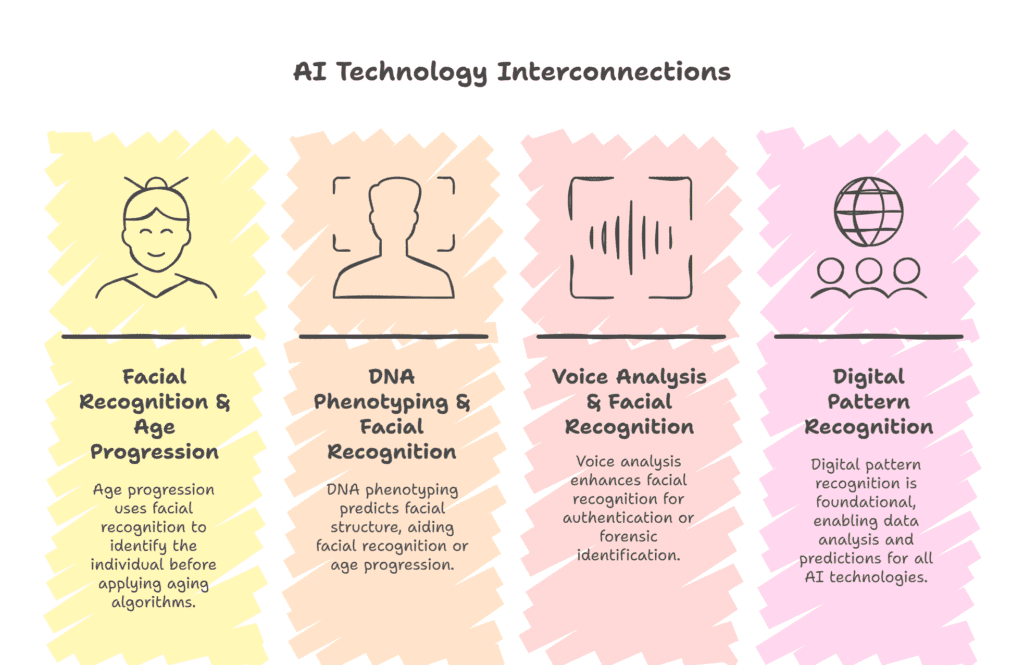
Facial Recognition and Age Progression:
One of the most powerful AI tools in investigating such cold cases is facial recognition technology. Modern AI systems can accurately match faces across vast databases of images, helping to identify suspects or victims who might have otherwise remained anonymous. In India, police departments are increasingly relying on these systems to scan surveillance footage, social media images, and other visual data sources.

Technological advancements have remarkably improved AI capabilities, enabling it to predict how a person’s appearance may change over time. Age progression algorithms analyse facial features and employ sophisticated models of how human faces typically age to generate images representing how a person might look years or even decades after their last known photograph. This capability has proven helpful in cases where suspects have evaded law enforcement authorities for many years, allowing investigators to search for individuals based on their likely current appearance rather than outdated, age-old photographs.
DNA Analysis and Phenotyping:
Although conventional DNA analysis has certain limitations, it can only identify suspects whose DNA can be directly tested for comparison or whose DNA is already stored in a database. Nonetheless, DNA evidence has long been regarded as the gold standard in forensic science. Through techniques like DNA phenotyping, which predicts physical traits from DNA samples, artificial intelligence is helping to overcome the current constraints.
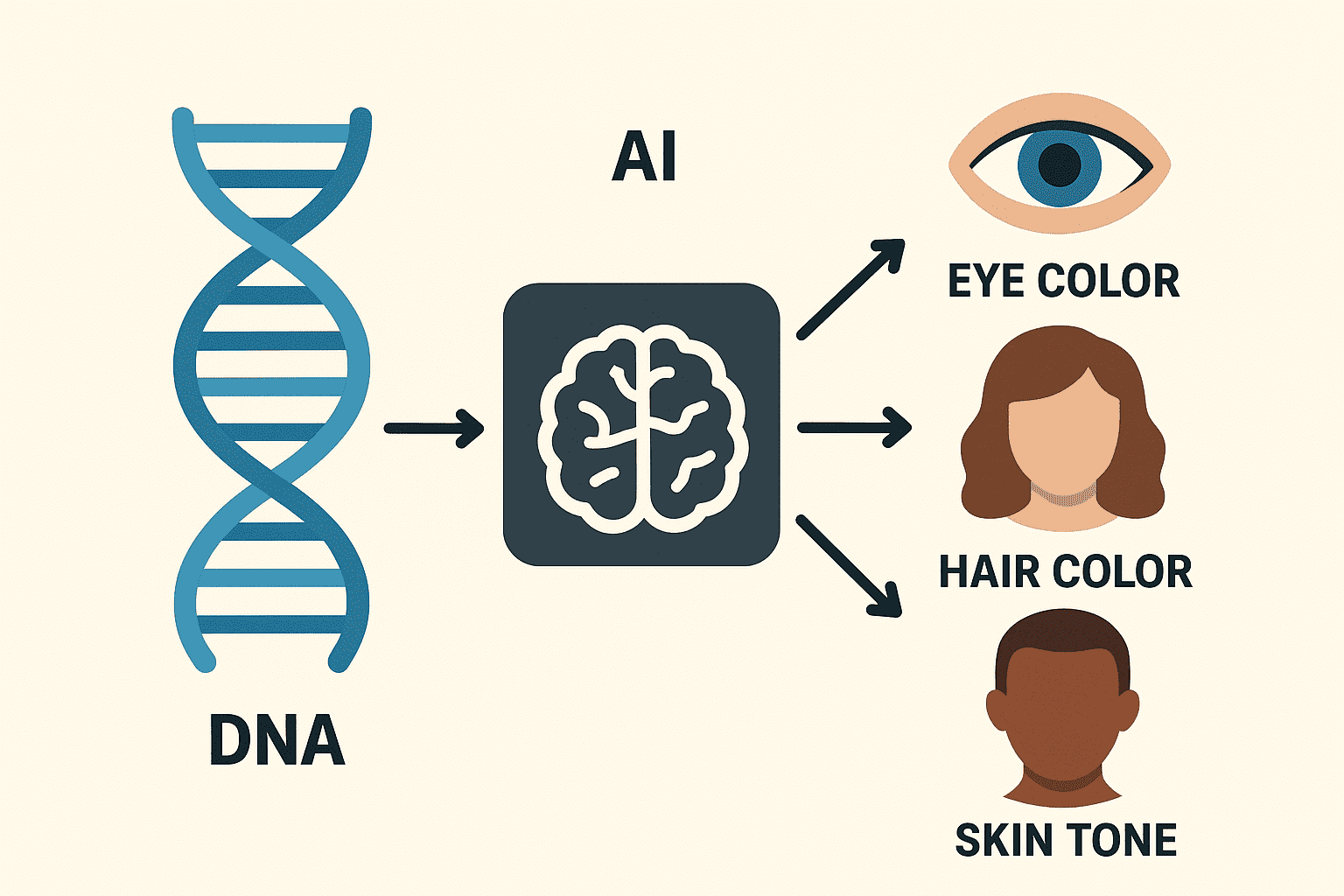
By using machine learning algorithms, scientists can now analyse DNA to predict a person’s physical features, such as eye colour, hair colour, skin tone, and even facial structure, with greater accuracy. This allows investigators to create physical profiles of suspects, even when there are no witnesses or other means of identification. Although still developing, these techniques offer promising new options for cases where traditional DNA matching has failed to produce results.
Voice Synthesis and Audio Analysis:
Voice evidence has always been challenging to handle because voice samples often have poor quality, background noises, and impersonation of others. However, AI is playing a transformative role in this area, as advanced algorithms can now improve poor-quality audio recordings, filter out background noise, and even recognise speakers based on vocal patterns. This has proven extremely valuable in cases involving ransom calls, recorded threats, or other audio evidence.
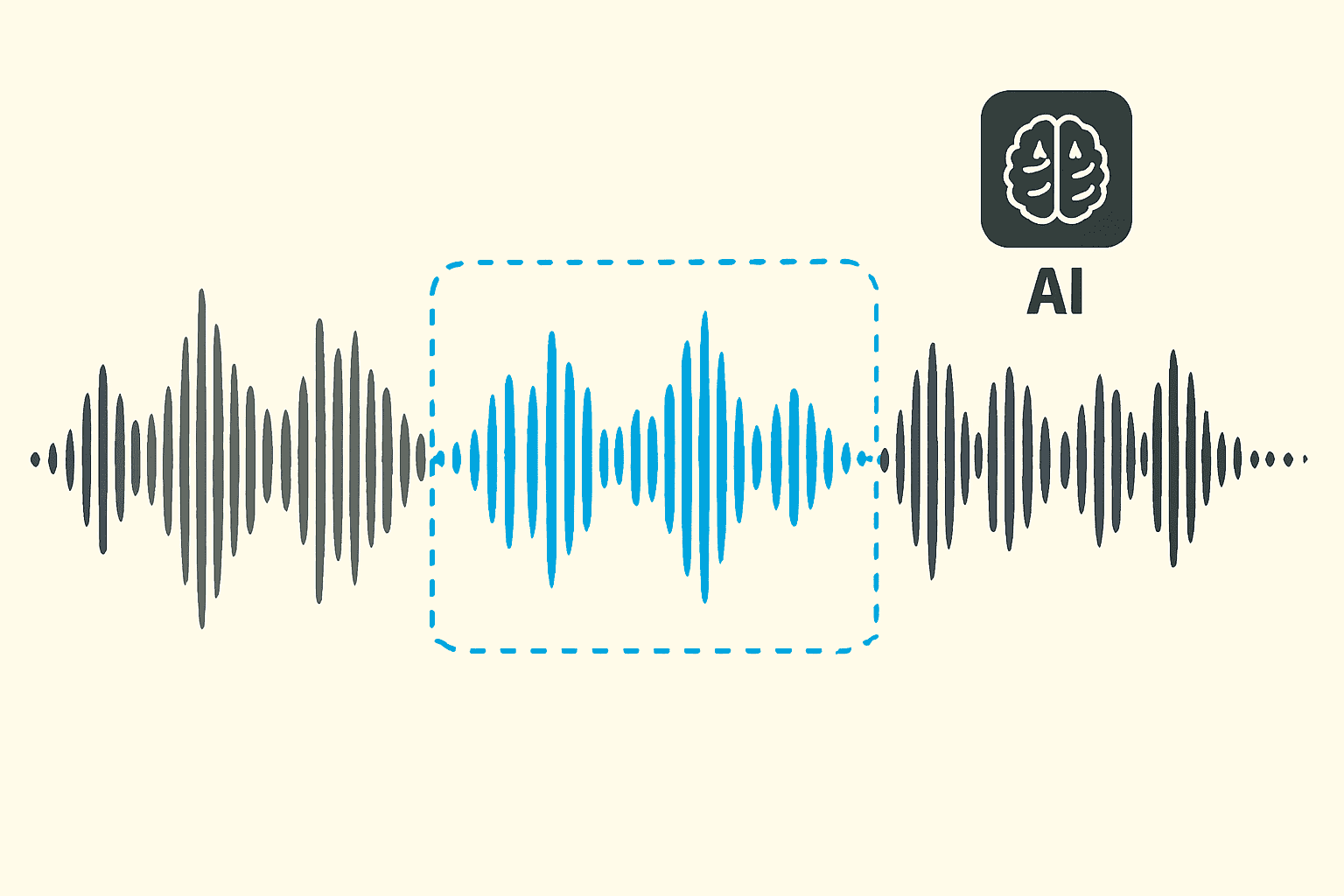
In India, researchers are developing voice comparison algorithms specifically designed for forensic purposes that can assist in identifying suspected voice samples. As voice-related crimes increase, including AI-enabled voice scams, these technologies are becoming increasingly essential for solving cold cases and preventing new ones.
Digital Forensics and Pattern Recognition:
Perhaps the most widely applicable AI capability in cold case investigations is pattern recognition across large datasets. Modern investigations require extensive digital evidence to process, such as phone records, financial transactions, social media activities, surveillance footage, and more. Human investigators cannot manually analyse all this humongous information.
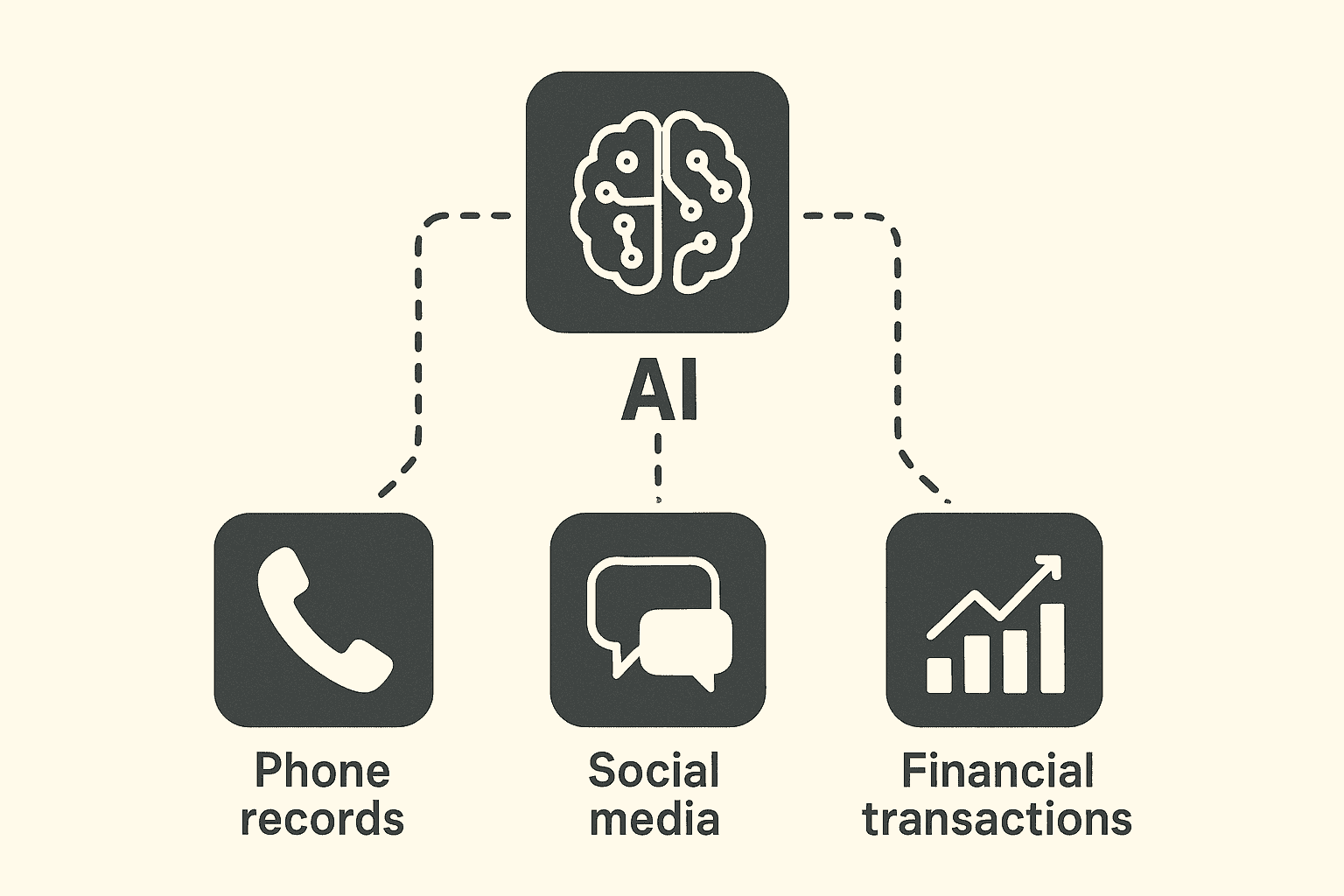
AI systems excel at uncovering patterns in huge datasets. They can identify connections between seemingly unrelated events, detect anomalies that may indicate criminal activity, and generate new investigative leads based on correlations that human analysts might overlook. Globally, law enforcement agencies are increasingly relying on these tools to make sense of complex digital evidence in both new and cold cases.
Real-World Success Stories
The Kerala Triple Murder: AI Facial Recognition After 19 Years
One of the most remarkable cold case breakthroughs in India came recently in 2025, when the Kerala Police solved a brutal triple murder case that had remained unsolved for 19 years. In February 2006, a woman named Ranjini and her 17-day-old twin daughters were found murdered in their home in Anchal, Kollam district, their throats slit. Police quickly identified two suspects—Divil Kumar and Rajesh, both army personnel stationed at the Pathankot military base—but the men vanished without a trace.
The case remained cold until 2023, when the Technical Intelligence Wing of the Kerala Police chose to revisit it using cutting-edge AI technology. They employed artificial intelligence to progressively age available old photographs of the suspects, predicting how they might appear after 19 years. These AI-generated images were then compared with photographs on social media platforms.
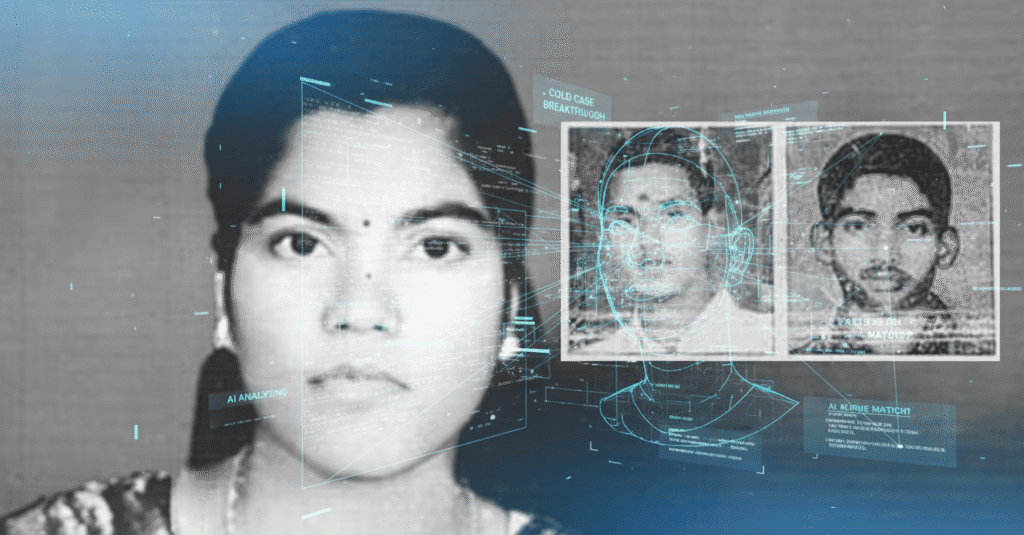
The breakthrough came when one of the AI-generated images revealed a 90% match with a wedding photograph found on Facebook. This led investigators to a man living in Puducherry under the name “Praveen Kumar”, who was actually Rajesh, one of the original suspects. Through him, they also located Divil Kumar, who lived under the false identity “Vishnu” and worked as an interior designer. Both men had married schoolteachers and constructed new lives under assumed identities. The case was transferred to the CBI, which made the arrests in January 2025.
The Delhi Blind Murder: Digital Reconstruction
In January 2024, the Delhi Police faced a challenging “blind murder” case when an unidentified dead body was found near the Geeta Colony flyover. Without any identification documents for the victim and no immediate leads, investigators were at a standstill. The autopsy determined that the cause of death was strangulation, but without knowing the victim’s identity, the investigation could not proceed any further.
A team of 30 police personnel turned to AI technology to solve the case. They utilised artificial intelligence to digitally reconstruct the victim’s face, creating an image with open eyes and a modified background that would be more recognisable to the public. Within 72 hours of the murder, this AI-generated image was disseminated across Delhi through over 400 strategically positioned posters and shared digitally via WhatsApp groups.
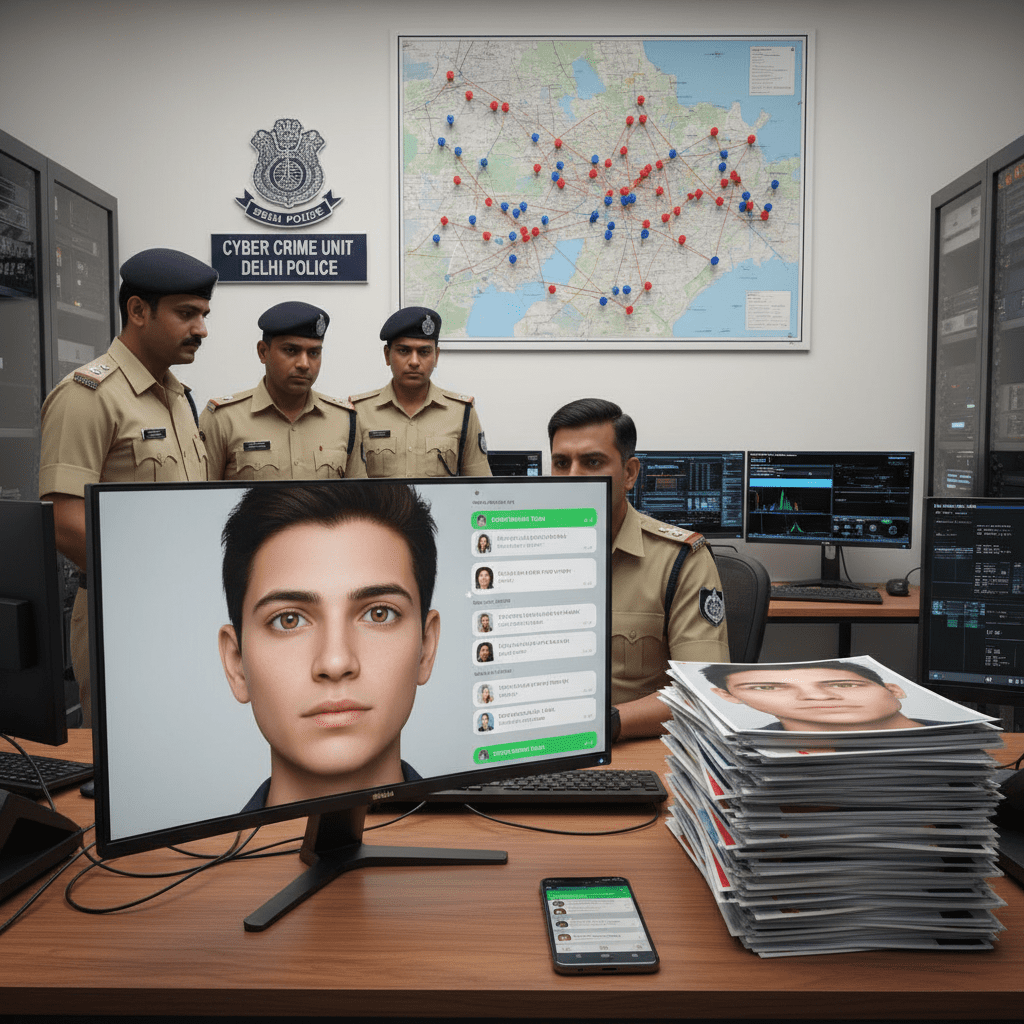
A man recognised the victim, his brother Hitendra, from a poster outside a police station, allowing the investigation to advance. It was discovered that Hitendra had fought with two individuals over a woman two months prior. On January 9, the accused, who were intoxicated, strangled him to death. Four people, including a woman and a cab driver, have been arrested, showcasing how AI can provide vital leads in previously unsolvable cases.
The Golden State Killer: International Benchmark
The Golden State Killer investigation remains the international gold standard for AI-assisted cold case resolution and has influenced investigative approaches worldwide, including in India. Joseph James DeAngelo terrorised California communities between 1974 and 1986, committing 13 murders, over 50 rapes, and more than 100 burglaries. Despite extensive investigations and DNA evidence, the case remained unsolved for decades.
The breakthrough came in 2018 through a revolutionary approach combining DNA analysis with AI-powered genetic genealogy. Investigators uploaded the killer’s DNA profile to GEDmatch, a genealogical website that aggregates DNA data. AI algorithms identified 10 to 20 people who shared the same great-great-great-grandparents as the killer.
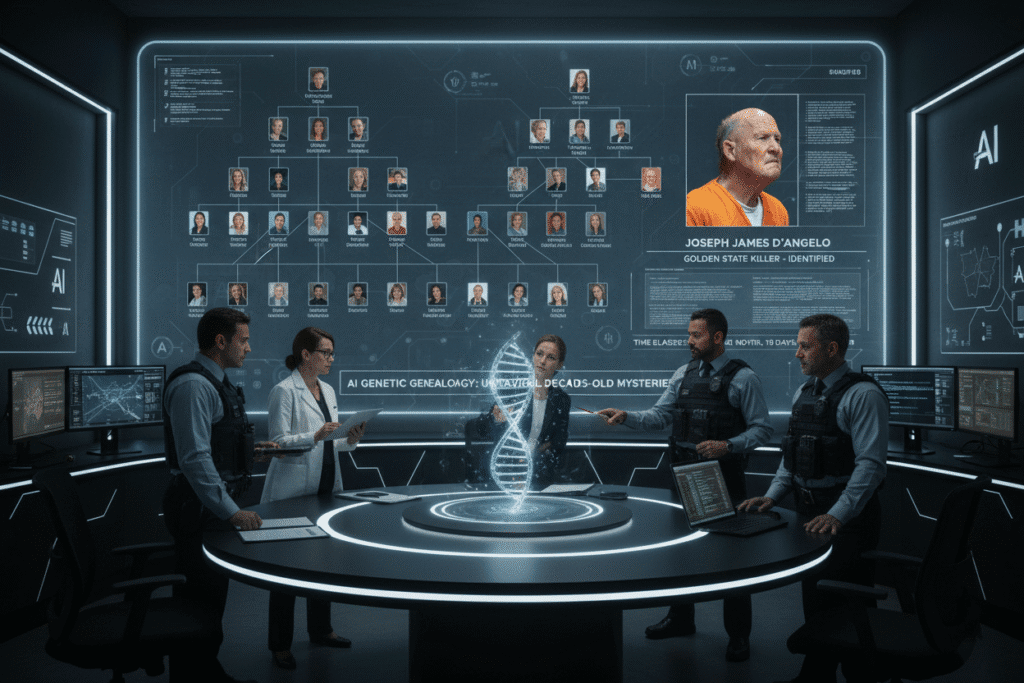
Working with genealogist Barbara Rae-Venter, investigators constructed a detailed family tree, analysing third cousins—a task nearly impossible without AI. They narrowed down potential suspects by age, geography, and other factors, identifying DeAngelo. Covert DNA collection confirmed the match, leading to his arrest and guilty plea. Since then, over 150 suspects have been identified through genetic genealogy.
AI-Driven Case Prioritisation: A New Frontier
The Solvability Matrix Revolution
Beyond resolving individual cases, AI is transforming how law enforcement agencies should allocate their limited resources. The Netherlands police have pioneered an AI system that ranks cold cases by “solvability,” determining which investigations are most likely to produce results with current technology. The aim is for the AI to analyse pending cold cases, which are digitised, and identify those with promising evidence that could lead to solving the case.
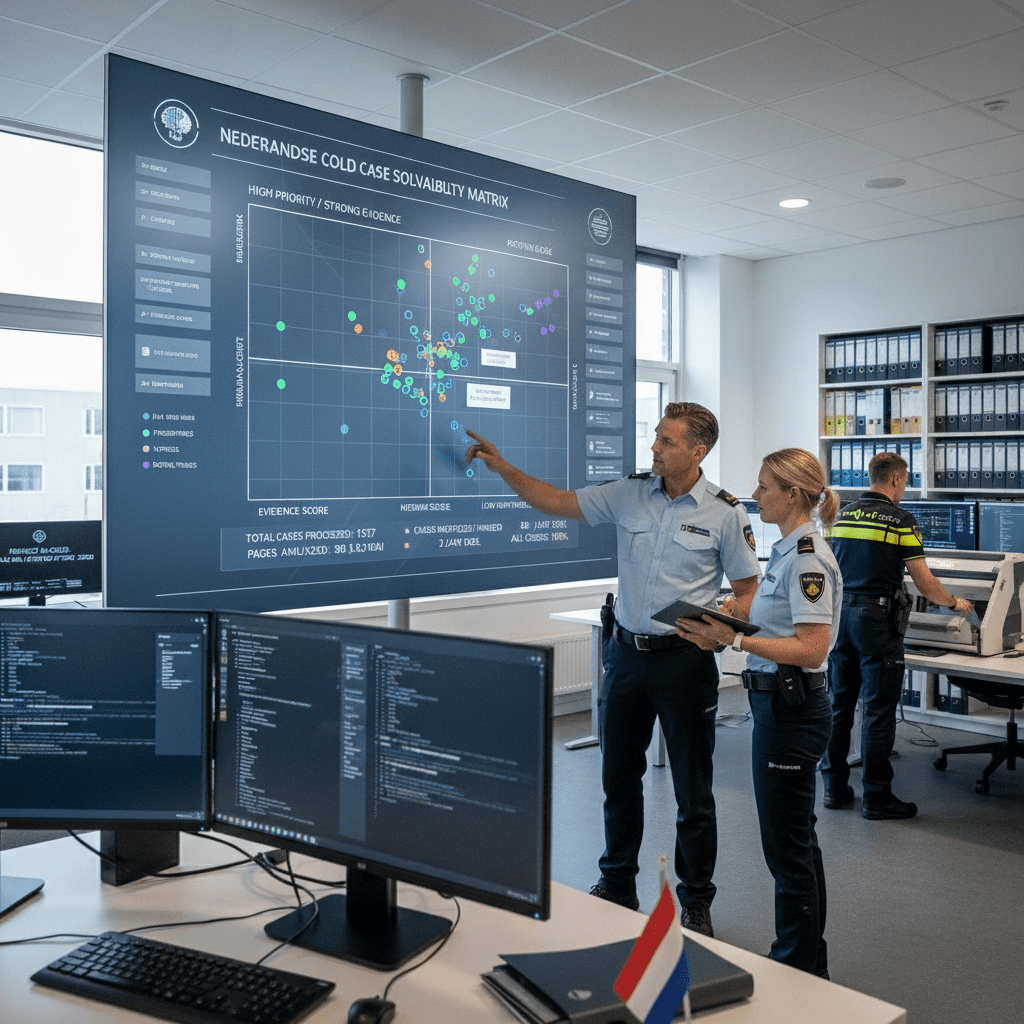
This AI-based triage system analyses DNA evidence, witness quality, forensic potential, and technology to generate priority rankings. The Dutch system processes over 1,500 cold cases and 30 million pages, creating a database that identifies patterns. Law enforcement expects to digitise all cold cases within a year and complete a prioritised list in two years. The platforms prioritise cases with unprocessed DNA or overlooked fingerprints, indicating where investigators should start.
Key Technological Breakthroughs
Pattern Mining in Complex Data
One of the most significant breakthroughs in AI for criminal investigations is its ability to mine patterns across diverse and complex datasets. Traditional investigation methods often struggle with information overload; the sheer volume of data generated in modern cases can overwhelm human analysts. AI excels at discovering connections and patterns that humans might overlook.
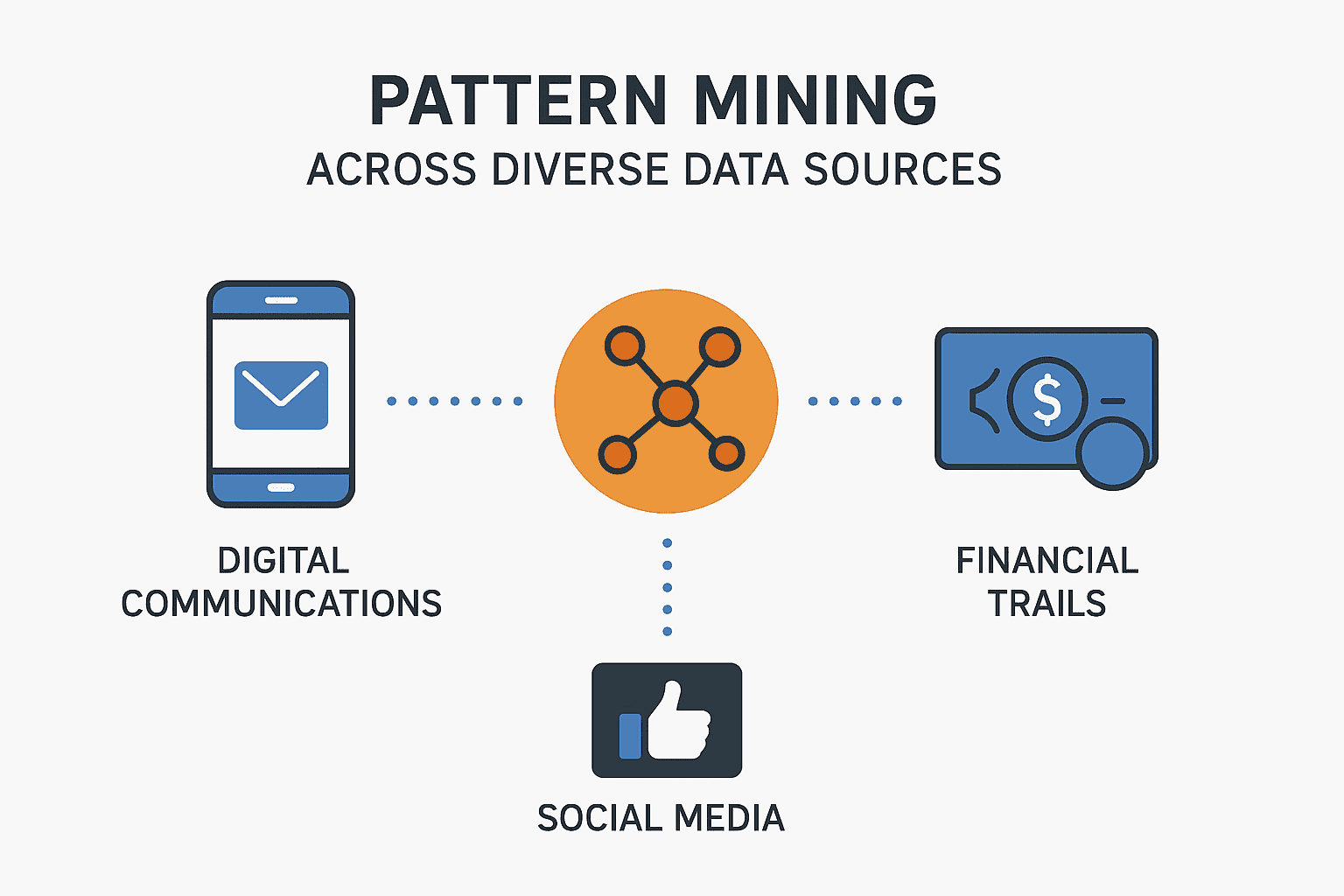
In India, law enforcement agencies are increasingly utilising pattern recognition technology to analyse various online data sources, including servers, digital communications, websites, and social media. These systems can detect patterns in criminal behaviour, identify anomalies in financial transactions that may indicate fraud, and uncover hidden actions of suspicious users. The technology has proven particularly valuable in complex cases involving multiple suspects or crimes committed across different jurisdictions.
Advanced Genetic Genealogy
The development of sophisticated genetic genealogy models represents another crucial breakthrough. AI systems can now analyse complex DNA relationships with remarkable precision, even when dealing with degraded or mixed samples. Machine learning algorithms, trained on large genetic datasets, can identify familial connections through multiple generations, creating detailed family trees that guide investigations.
These systems use hierarchical classification strategies that first determine relationship degrees (first, second, third cousins) and then identify specific relationship types within each degree. The technology has proven particularly robust when dealing with high error rates in genetic data, maintaining accuracy even when traditional DNA matching fails.
Cross-Database Matching
Another powerful capability is cross-database matching – the ability to discover connections between different datasets that were not originally designed to function together. This approach enables investigators to identify common subjects across independent databases, potentially revealing associations that would otherwise remain concealed.
British police trials demonstrated this capability when AI systems analysed 27 complex cases in just 30 hours—work that would have taken human investigators up to 81 years to complete manually. The systems can process video footage, financial transactions, social media posts, emails, and other documents simultaneously, identifying patterns across multiple data types.
Limitations and Ethical Challenges
Algorithmic Bias and Fairness
Despite its potential, AI in criminal investigations presents significant limitations and ethical concerns. Perhaps the most pressing is algorithmic bias—the tendency of AI systems to reflect and potentially amplify biases present in their training data. If historical policing data mirrors biased practices, AI systems trained on that data may perpetuate or even exacerbate those biases.

This is concerning in a diverse country like India, where social divisions based on religion, caste, class, and region are significant. AI systems that disproportionately target certain communities for investigation may perpetuate injustice and erode public trust in law enforcement and the justice system. AI algorithms can unintentionally carry biases from training data, resulting in unfair outcomes, especially in forensic investigations where decisions have serious consequences for individuals.
Privacy Concerns and Surveillance
The power of AI to analyse vast amounts of data also raises serious privacy concerns. Facial recognition systems can effectively turn any camera into a surveillance device, tracking individuals across public spaces without their knowledge or consent. DNA databases can reveal sensitive information not just about suspects but about their relatives. Cross-database matching can create comprehensive profiles of individuals by combining data from multiple sources.
While the AI evaluation is good, it cannot replace firsthand experience. Without the ability to smell, see, or feel the atmosphere, crucial elements are lost that images alone cannot capture. The risk of a surveillance state through AI requires careful regulatory oversight and clear limitations on AI capabilities.
Transparency and Explainability
Many advanced AI systems operate as “black boxes”—their decision-making processes are not transparent or easily explainable. This lack of transparency raises serious concerns in criminal investigations, where the stakes could not be higher.
Current AI technologies show great promise as decision support systems in forensic science, acting as quick initial screening tools. However, experts stress that these tools should “enhance rather than replace expert forensic analysis.” The issue of AI explainability becomes especially crucial when AI-generated evidence is introduced in court, where both the accused and the court need to comprehend the process behind the conclusions drawn.
AI as Assistant, Not Replacement
The Complementary Role of Technology
Despite these challenges, it’s important to recognise that AI is not replacing traditional policing and investigation work—it’s augmenting and enhancing it. The most effective approach combines AI’s pattern-recognition capabilities with the contextual understanding, ethical judgment, and investigative experience of human officers.
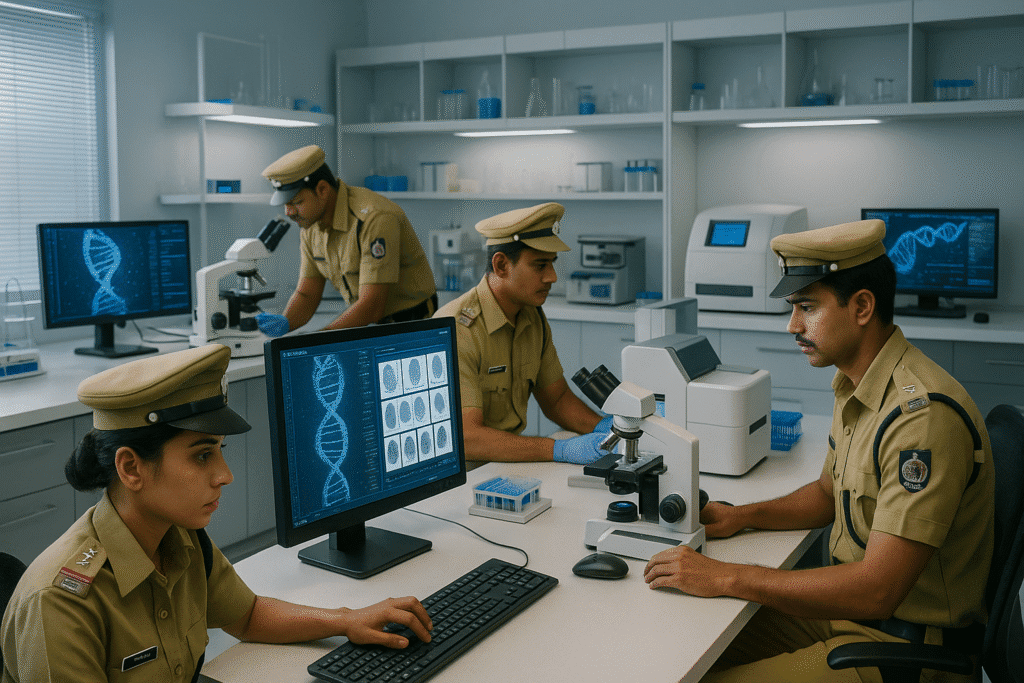
AI is not intended to replace investigators but to enhance their capabilities. Investigators rely upon their training, experience and intuition, whereas AI processes large amounts of data quickly and accurately. This collaboration between humans and AI generates a powerful synergy in solving cold cases.
The Human Element in Investigation
Some aspects of criminal investigation remain fundamentally human. Building rapport with witnesses, understanding community dynamics, and recognising the emotional and psychological dimensions of criminal behaviour—these are areas where human investigators continue to excel. AI can analyse what has occurred based on data, but understanding why it has happened often requires human insight.
A fresh perspective can transform the status of these cases to cleared and closed. While AI provides a “fresh perspective” in data analysis, human investigators contribute the wisdom, empathy, and judgment to navigate criminal justice’s complex social and ethical dimensions.
The Road Ahead: Future Directions
Policy and Regulatory Frameworks
As AI becomes increasingly integrated into criminal investigations, India needs comprehensive policy and regulatory frameworks to govern its use. These frameworks should address issues of data privacy, algorithmic transparency, accountability for AI-driven decisions, and safeguards against misuse.
India’s approach to AI in criminal investigations operates within the framework of the Crime and Criminal Tracking Network and Systems (CCTNS) and the Inter-operable Criminal Justice System (ICJS). The ICJS project, with the NCRB as the nodal agency, aims to integrate police, courts, jails, forensic labs, and prosecution systems to “enable effective use of data analytics and AI/ML tools available in the investigations.” This infrastructure provides the technological backbone for AI-assisted cold case investigations, facilitating seamless data sharing between forensic laboratories and investigative agencies across jurisdictions.
The Digital Personal Data Protection Act serves as a starting point; however, more specific regulations tailored to law enforcement applications of AI may be necessary. These should balance the legitimate needs of investigators with the safeguarding of civil liberties and privacy rights. Furthermore, international cooperation will be crucial, as criminal investigations increasingly transcend national boundaries.
Training and Infrastructure Needs
Effective implementation of AI in cold case investigations requires significant investments in both human capital and technical infrastructure. Police officers need training not just in how to use AI tools but also in how to interpret their outputs critically and understand their limitations and potential biases.
The Government of India has prioritised forensic modernisation through initiatives including upgrading Central Forensic Sciences Laboratories with new disciplines in “Digital Forensics, DNA Forensic analysis, Forensic Psychology,” and establishing state-of-the-art DNA Analysis facilities. These developments directly support AI integration in cold case investigations by providing the necessary infrastructure and expertise for advanced forensic analysis.
Technical infrastructure—from secure data storage to high-performance computing resources—is equally important. In a country as large and diverse as India, ensuring that these resources are available across different states and regions, not just in major metropolitan areas, represents a significant challenge.
Emerging Technologies and Approaches
Looking forward, several emerging technologies promise to further enhance cold case investigations. Quantum computing could dramatically speed up forensic data processing. Blockchain-based systems could provide tamper-proof digital evidence. And increasingly sophisticated AI models might be able to predict criminal behaviour with greater accuracy, potentially preventing crimes before they occur.
However, each of these advances brings its own ethical and practical challenges. As we embrace these new capabilities, we must remain vigilant about their potential for misuse and committed to using them to enhance justice rather than undermining it.
Conclusion: The Future of Justice
The integration of AI into cold case investigations represents a transformative moment in how we approach unsolved crimes. From the Kerala triple murder to cases across the globe, we’ve witnessed how these technologies can shed insights on cases that have remained unsolved for decades, bringing long-awaited justice to victims’ families.
Yet this technological revolution demands careful stewardship. As forensic expert Professor Pekka Santtila of NYU Shanghai observes: “a promising future role for AI in supporting legal decision-making, particularly in evaluating complex scientific evidence where human biases and misunderstandings frequently occur. However, the challenge lies in ensuring that enhanced investigative capabilities do not compromise the fundamental principles of justice and equality.

The Netherlands’ pioneering case prioritisation system offers a glimpse of AI’s potential to revolutionise not just individual investigations but entire approaches to criminal justice resource allocation. Yet, as research demonstrates, “current AI tools function optimally as assistive technologies, enhancing rather than replacing expert forensic analysis, particularly in scenarios involving multiple evidence points or high-volume caseloads.”
The path forward requires India to harness AI’s analytical power within existing frameworks like CCTNS and ICJS while preserving human judgment, ethical oversight, and the constitutional guarantees that technology can enhance but never replace. In this delicate balance lies the promise of offering hope to those victims who have waited years, even decades, for answers.
FAQs
What are cold cases?
Cold cases refer to criminal investigations that have remained unsolved for an extended period, often due to a lack of evidence or leads. These cases may involve missing persons, homicides, or other serious crimes where the perpetrator has not been identified or apprehended. Law enforcement agencies continue to review these cases periodically, hoping that new evidence or witness testimony will emerge.
How can a missing person case become a cold case?
A missing person case can become a cold case when law enforcement has exhausted all leads and investigative avenues without success. If a person is reported missing and no significant evidence or witness testimony emerges, the case may be classified as cold. Years later, it can still remain unsolved, making it a mystery for families and authorities alike.
How do cold cases get reopened?
Cold cases may be reopened when new evidence comes to light, such as witness testimony or advancements in forensic science, like DNA profiling. Additionally, if a cold case unit within a police department identifies a case that warrants reexamination, they may pursue it again, particularly if it involves significant public interest or potential for resolution.
Can new technology help solve cold cases?
Yes, advancements in technology, such as genetic genealogy and improved forensic analysis, can significantly aid in solving cold cases. For instance, DNA profiles can be compared to existing databases to identify potential suspects or relatives of victims, leading to new arrests and convictions in cases that have remained unsolved for years.
What happens when remains are found in a cold case?
When remains are discovered in a cold case, law enforcement typically conducts a thorough investigation to determine the identity of the deceased and the circumstances surrounding their death. This may involve forensic analysis to establish the cause of death and to look for signs of foul play, which could lead to reopening the case and seeking justice for the victim.
How can the public help with cold cases?
The public can play a vital role in helping to solve cold cases by providing tips or information to law enforcement. If someone has knowledge of a case, whether it’s details about a suspect’s activities or new witness testimony, they can contact local authorities. These contributions can be crucial in cracking a case that has remained a mystery for years.
What qualifies as a cold case?
A cold case is an unsolved criminal investigation, typically a homicide, that has not been active for a significant period, often years. These cases can remain unsolved due to a lack of evidence, leads, or witnesses. As time passes, however, new technology or information may emerge that could help crack the case.
What are some other famous cold cases that remain unsolved?
Apart from the ones discussed in the above article, there are many famous cold cases, including the Zodiac Killer, who taunted police with letters while committing a series of murders. Other notorious cases include the disappearance of missing persons in Kansas City and numerous unsolved murders that have haunted families for decades.
How do law enforcement agencies handle cold cases?
Law enforcement agencies may reexamine cold cases periodically. They look for new evidence, witness testimonies, or advancements in forensic science, such as DNA profiling, to help solve these long-standing mysteries.
What happens to cold cases after many years?
Cold cases can remain unsolved for many years, but they are not forgotten. Law enforcement may revisit them periodically, especially if new information surfaces, such as a DNA profile or a possible suspect’s confession. These cases can be reopened even decades later.
How have cold cases been solved in the past?
Cold cases have been solved through various means, including the discovery of new evidence, advancements in forensic methods, and tips from the public. For example, a cold case murder may be resolved when someone comes forward with information that leads to an arrest or when a DNA match is found that connects a suspect to the crime.
What is the significance of the last seen details in cold cases?
Details about where a victim was last seen can be crucial in cold cases. They help law enforcement establish a timeline and focus their investigation on specific areas or individuals. For instance, knowing a missing person’s last seen location can lead to important evidence found in a nearby crime scene.








Appreciate your effort in writing such valuable news. This gives readers awareness about the power of AI in criminal investigations.
Thank you, Pandey Jee